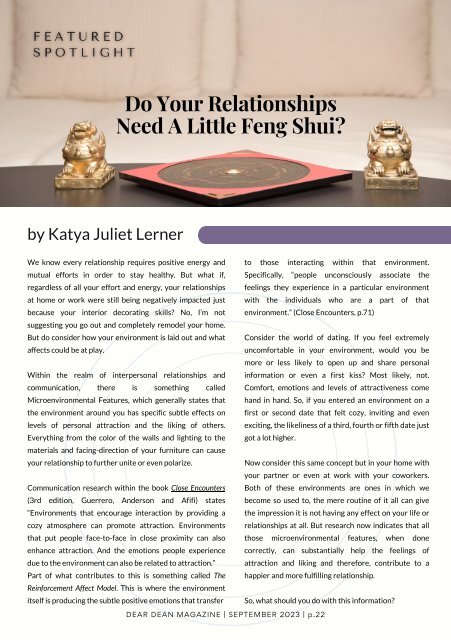Dear Dean Magazine: September 2023
Dear Dean Magazine: Issue 21 | September 2023 By Myron J. Clifton | Subscribe free online www.deardeanpublishing.com/subscribe
Dear Dean Magazine: Issue 21 | September 2023 By Myron J. Clifton | Subscribe free online www.deardeanpublishing.com/subscribe
Create successful ePaper yourself
Turn your PDF publications into a flip-book with our unique Google optimized e-Paper software.
Do Your Relationships<br />
Need A Little Feng Shui?<br />
by Katya Juliet Lerner<br />
We know every relationship requires positive energy and<br />
mutual efforts in order to stay healthy. But what if,<br />
regardless of all your effort and energy, your relationships<br />
at home or work were still being negatively impacted just<br />
because your interior decorating skills? No, I’m not<br />
suggesting you go out and completely remodel your home.<br />
But do consider how your environment is laid out and what<br />
affects could be at play.<br />
Within the realm of interpersonal relationships and<br />
communication, there is something called<br />
Microenvironmental Features, which generally states that<br />
the environment around you has specific subtle effects on<br />
levels of personal attraction and the liking of others.<br />
Everything from the color of the walls and lighting to the<br />
materials and facing-direction of your furniture can cause<br />
your relationship to further unite or even polarize.<br />
Communication research within the book Close Encounters<br />
(3rd edition, Guerrero, Anderson and Afifi) states<br />
“Environments that encourage interaction by providing a<br />
cozy atmosphere can promote attraction. Environments<br />
that put people face-to-face in close proximity can also<br />
enhance attraction. And the emotions people experience<br />
due to the environment can also be related to attraction.”<br />
Part of what contributes to this is something called The<br />
Reinforcement Affect Model. This is where the environment<br />
itself is producing the subtle positive emotions that transfer<br />
to those interacting within that environment.<br />
Specifically, “people unconsciously associate the<br />
feelings they experience in a particular environment<br />
with the individuals who are a part of that<br />
environment.” (Close Encounters, p.71)<br />
Consider the world of dating. If you feel extremely<br />
uncomfortable in your environment, would you be<br />
more or less likely to open up and share personal<br />
information or even a first kiss? Most likely, not.<br />
Comfort, emotions and levels of attractiveness come<br />
hand in hand. So, if you entered an environment on a<br />
first or second date that felt cozy, inviting and even<br />
exciting, the likeliness of a third, fourth or fifth date just<br />
got a lot higher.<br />
Now consider this same concept but in your home with<br />
your partner or even at work with your coworkers.<br />
Both of these environments are ones in which we<br />
become so used to, the mere routine of it all can give<br />
the impression it is not having any effect on your life or<br />
relationships at all. But research now indicates that all<br />
those microenvironmental features, when done<br />
correctly, can substantially help the feelings of<br />
attraction and liking and therefore, contribute to a<br />
happier and more fulfilling relationship.<br />
So, what should you do with this information?<br />
DEAR DEAN MAGAZINE | SEPTEMBER <strong>2023</strong> | p.22

















